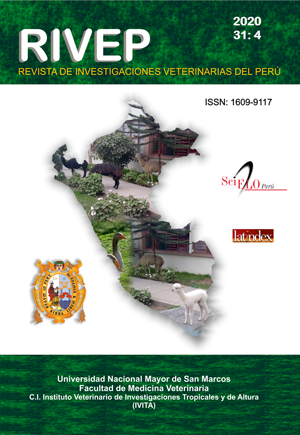Evaluation of photolysis, photolysis/H2O2 and H2O2 as treatments for the reduction of Salmonella spp in water of pig farms
DOI:
https://doi.org/10.15381/rivep.v31i4.17205Keywords:
photolysis UV, photolysis/H2O2, Salmonella spp inactivation, water, porcine industryAbstract
The aim of this study was to evaluate three processes for the removal of organic matter and inactivation of Salmonella spp re inoculated in water from pig farms. Specific water samples were obtained to perform physical, chemical and microbiological characterization. Next, the operating conditions that favored the photolysis process were selected through a 2x2 factorial design. Finally, inactivation/removal kinetics were carried out, assessing UV254 nm photolysis, UV254 nm photolysis with hydrogen peroxide H2O2 at 15 ppm and hydrogen peroxide H2O2 at 15 ppm. The inactivation of Salmonella spp was favored by using an aeration of 1 L/min and with a concentration of Salmonella spp of 1x104 UFC/ml obtaining an inactivation of 97.3±1.9% after 10 minutes of treatment. On the other hand, for the inactivation kinetics it was established that the best treatments were photolysis and photolysis/H2O2, without significant differences. At 30 seconds of exposure, the inactivation of Salmonella was 99.9±2.4% in T1, with a removal of chemical oxygen demand (COD), NO3 and NO2 of 30±2, 27±3, 83±4, 41±1.0 and 99±5% for T1 and T2 respectively. The bacteria recovered in T2 and T3 and the treatments had no residual effect, determining that the final populations were 8 CFU/ml and 3x103 CFU/ml, respectively.
Downloads
Downloads
Published
Issue
Section
License
Copyright (c) 2020 Cynthia Lorena Valencia, Aura M. Pedroza-Rodríguez, Iliana Constanza Chamorro Tobar, Diana Corina Zambrano, Ana Karina Carrascal Camacho

This work is licensed under a Creative Commons Attribution-NonCommercial-ShareAlike 4.0 International License.
AUTHORS RETAIN THEIR RIGHTS:
a. Authors retain their trade mark rights and patent, and also on any process or procedure described in the article.
b. Authors retain their right to share, copy, distribute, perform and publicly communicate their article (eg, to place their article in an institutional repository or publish it in a book), with an acknowledgment of its initial publication in the Revista de Investigaciones Veterinarias del Perú (RIVEP).
c. Authors retain theirs right to make a subsequent publication of their work, to use the article or any part thereof (eg a compilation of his papers, lecture notes, thesis, or a book), always indicating the source of publication (the originator of the work, journal, volume, number and date).



